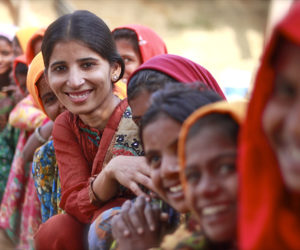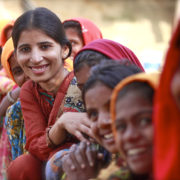This World Population Day; Invest in Girls by Investing in Youth-focused SBCC
What is the best way to ensure sustainable development?
According to the United Nations Population Fund (UNFPA), it is through a world where every pregnancy is wanted, every birth is safe and every young person’s potential is fulfilled.
On this World Population Day focused on investing in teenage girls, it is worth pointing out the role social and behavior change communication (SBCC) plays in empowering young women.
This is particularly true in the area of reproductive health.

© 2011 Tanzeel Ur Rehman / Cover Asia Press, Courtesy of Photoshare
Pregnancies and childbearing during the teenage years are associated with significant health risks for adolescent women, especially in low- and middle-income countries where related complications are the leading cause of death among girls aged 15 to 19. It is essential to ensure that adolescent girls are given the tools to make healthy choices so they can lead healthy and successful lives.
For program managers who work for and with youth, the Urban Adolescent Sexual and Reproductive Health Social and Behavior Change Communication Implementation Kit provides a selection of Essential Elements and tools to guide the creation, or strengthening, of sexual and reproductive health (SRH) SBCC programs for urban adolescents aged 10 to 19. By focusing on a fictional setting, the I-Kit helps providers think critically about different (youth) audiences and navigate the pros and cons of working in the world’s bustling cities to develop effective SRH programs for this formative generation.
LARCs
For providers who counsel young women about modern contraceptive methods, one option to include is long-acting reversible contraceptive methods (LARCs). For young women, LARCs are ideal methods of contraception, since they are not only safe, but highly effective, easy to use and eliminate the need to remember contraception on a daily basis. Use of LARCs among this age group is growing, but slowly. For program managers who work with providers, and who want to improve the FP methods and counseling available to young women, HC3 has SBCC materials designed to help increase access to LARCs, including:
- A video aimed for providers who may counsel young women about modern contraceptive methods,
- A video discussion guide to help program managers or health facility senior staff facilitate deeper dives into the video’s key messages,
- A take-home brochure (in two versions: one with photos, one with stills from the video) that provides information on LARCs for dissemination in clinic or non-clinic settings,
- A series of posters encouraging youth to find out more information on LARCs, and consider them as an appropriate method for them.
High Parity before Advanced Maternal Age?
In many contexts, young women can reach high parity (five or more births) before they reach advanced maternal age (starting at age 35). For program managers working on healthy timing and spacing of pregnancy (HTSP), the HTSP Implementation Kit and associated resources can be used to train providers in particular to broach what is often a sensitive subject. While taboos around limiting pregnancies exist in many LMICs, family planning and spacing of pregnancies is more accepted in conservative contexts.
Though the I-Kit was originally designed for women who already had several births, or who were nearing age 35, material pretests showed young women also wanted access to information on AMA and HP pregnancy risks so they could plan from a young age to avoid them. Let’s hope this World Population Day serves as the vehicle to get information into the hands of those who can help teenage girls feel increasingly empowered.








Leave a Reply
Want to join the discussion?Feel free to contribute!